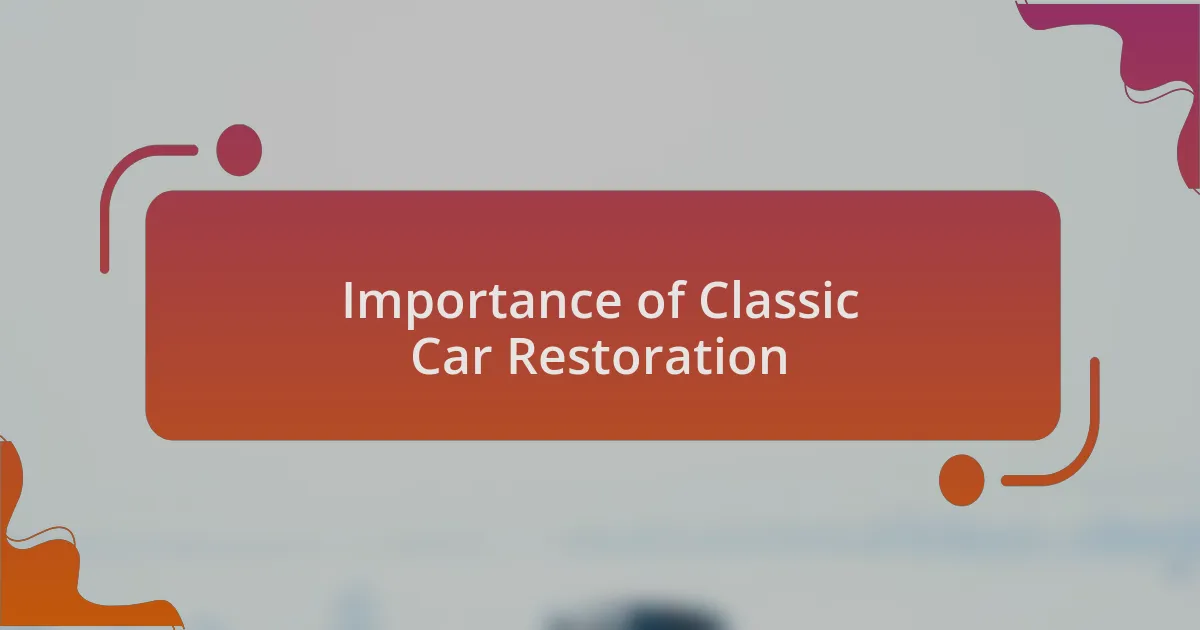Key takeaways:
- Vintage car expos create a community for enthusiasts to share knowledge, fostering a deeper appreciation for automotive history.
- Classic car restoration preserves memories and revives emotional connections while promoting sustainable practices.
- Finding the right car club is essential for personal growth, emphasizing the importance of a supportive and open environment.
- Successful restoration requires a clear plan, patience, and collaboration with fellow enthusiasts to navigate challenges effectively.

Understanding Vintage Car Expos
Vintage car expos serve as a haven for car enthusiasts, collectors, and anyone who appreciates the beauty of classic automobiles. I remember my first expo; I was overwhelmed by the array of makes and models, each telling a unique story. Have you ever stood in front of a beautifully restored car and felt a rush of nostalgia? It’s a sensation that connects you to the past.
These events not only showcase stunning vehicles but also serve as platforms for knowledge sharing. I often find myself chatting with other attendees, swapping restoration tips and techniques. It’s fascinating how much one can learn from fellow enthusiasts who have walked the same path of restoration; many times, their challenges can mirror ours. Don’t you think that sense of community enhances the experience?
The atmosphere is electric, filled with passion and a deep appreciation for automotive history. At one particular expo, a group organized a panel discussion on the future of vintage car preservation, sparking a thought within me: How can we maintain this rich heritage for future generations? These gatherings do more than just celebrate cars; they inspire us to preserve a piece of history that might otherwise fade away.

Importance of Classic Car Restoration
Classic car restoration is vital not only for preserving automotive history but also for reviving the memories and emotions tied to these vehicles. I recall restoring my first classic car; each dent and rust spot held a story waiting to be uncovered. Isn’t it incredible how a single car can invoke memories of a different era, connecting us to the love and craftsmanship of the past?
Beyond nostalgia, restoration serves as an opportunity to hone skills and forge connections within a community of like-minded enthusiasts. I remember attending a local workshop where everyone enthusiastically shared their struggles and victories. This collaboration sparked a deeper appreciation for the craft—what better way to bond than over the grease and grit of a shared passion?
Moreover, restoring a classic car can have environmental benefits by keeping a unique piece of machinery on the road, rather than letting it end up in a landfill. I often ponder the impact of extending the life of these beauties; every restored vehicle is a testament to sustainable practices in a throwaway culture. Don’t you feel that each restored classic is not just a car, but a piece of history that deserves to be celebrated?

Finding the Right Car Club
Finding the right car club can feel like navigating a maze, especially with the plethora of options available. After my initial restoration experience, I often found myself overwhelmed. I remember attending various meet-ups, evaluating the passion and camaraderie of each group. It was enlightening; what qualities should I look for in a community that truly aligns with my restoration goals?
For me, the club’s vibe mattered immensely. I once visited a club that focused solely on high-end restorations; while their expertise was impressive, I felt a disconnect. I realized that I thrived in a club where members shared not just skills but also a genuine love for all classic cars, regardless of their condition. Have you considered what type of environment encourages your growth as a restorer?
Through trial and error, I learned that the best clubs foster open communication and support. I still cherish the moments where experienced members shared their triumphs and lessons learned. These conversations sparked inspiration and motivation. When searching for the right fit, ask yourself: does this club foster an atmosphere of learning and encouragement? The connections you build can profoundly influence your restoration journey.

Key Challenges I Faced
One of the key challenges I faced was dealing with the unique quirks of my classic vehicle. The first time I dove under the hood, I encountered parts that were no longer produced, making sourcing replacements a real headache. I remember vividly scouring through online forums and local junkyards, feeling a mix of frustration and determination. Have you ever felt that rush when you finally track down a rare part? It’s both exhilarating and daunting at the same time.
Another hurdle was the learning curve associated with restoration techniques. I vividly recall the day I decided to take on the bodywork myself. I had watched countless videos, but nothing prepared me for the reality of welding and sanding. That moment when I realized I had cut too deep into the metal taught me a harsh lesson about patience and precision. How often do we underestimate the skills that seem straightforward until we try them ourselves?
Finally, coordinating with fellow club members posed its own set of challenges. While I valued their input, different opinions sometimes clashed, especially when it came to design choices. In one memorable discussion, my vision for a deep red paint job was met with resistance from a few members who preferred a more conservative shade. I learned to navigate these discussions by balancing my passion with openness to feedback. Isn’t it fascinating how differing perspectives can shape our restorations in unexpected ways?

Tips for Successful Restoration Projects
When embarking on a restoration project, one of the most essential tips I can offer is to develop a clear plan before diving in. I remember sketching out my objectives and timelines, which helped keep my enthusiasm in check. Have you ever jumped headfirst into a project only to realize midway that you were unprepared? It can be a recipe for added stress, so outlining each step can save you from unnecessary headaches.
Another crucial aspect of successful restoration is patience. There were moments where I wanted to rush through certain tasks, like engine detailing or upholstery work, but each time I slowed down, I found myself appreciating the process. I can recall spending an entire weekend meticulously reupholstering a single seat—painstaking work, but the satisfaction of that finished seat made it worthwhile. How often do we find that focusing on the details transforms a good project into a great one?
Lastly, don’t underestimate the value of community and collaboration. On several occasions, I reached out to club members for advice on tricky situations, like electrical systems that seemed like a tangled mess. Their insights not only provided clarity but also made me feel part of something larger than myself. Isn’t it wonderful how sharing our journeys can inspire and aid each other? Embracing this collaborative spirit can turn isolated projects into shared experiences that enrich us all.